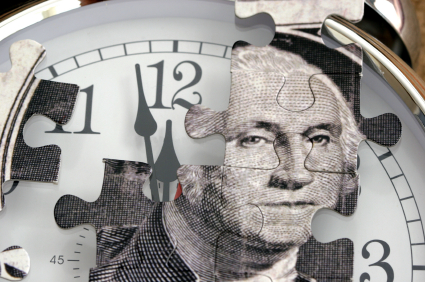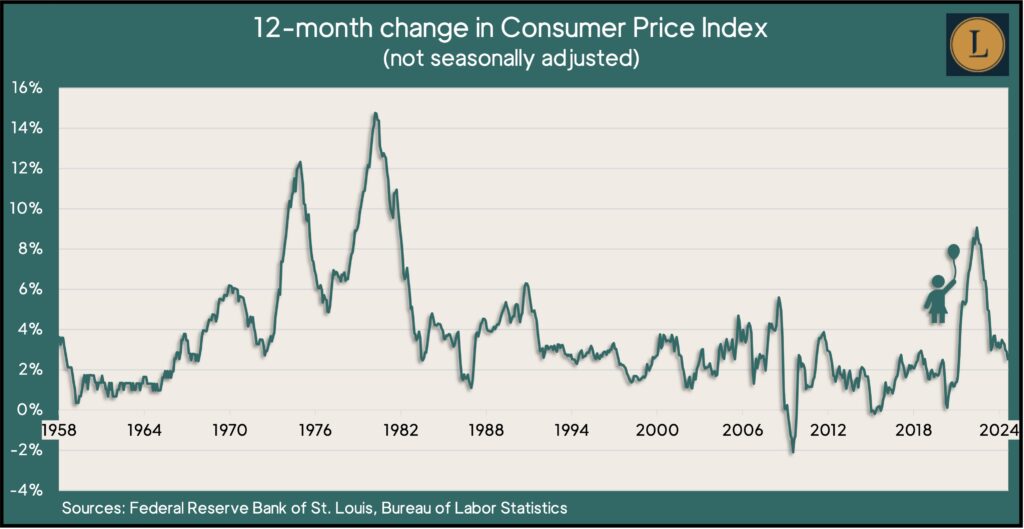
By Joel Dresang
I was doing laundry in the basement and didn’t duck enough under the clothes chute.
Not only did I feel the bottom of the chute scrape the top of my head, but I heard the skin tear. I bled – for a while. One of my daughters said I might need stitches.
Sometimes we learn from misfortunes that befall us.
When post-pandemic inflation spiked to a four-decade high in mid-2022, a lot of people suffered from the shock – including retirees.
“High inflation in later life is often harmful to retirement security,” economists at the Center for Retirement Research at Boston College noted in a recent report. Inflation surges can disrupt anyone’s income and wealth, but the researchers noted that retirees are particularly vulnerable: They no longer have the prospect of pay raises or overtime to offset higher prices. Their income relies more on investment earnings and on pensions, which usually don’t flex with inflation.
The September interest rate cut by the Federal Reserve signals that we may be safely past the days of 9% inflation. But while the pain is fresh in our memory, it’s a good time to consider how retired investors can deal with inflation.
The Center for Retirement Research report looks at what older adults did during the post-pandemic price upheaval. Among the findings:
- A significant portion of both retirees and those nearing retirement (ages 55 to 62) reduced saving and increased withdrawals – a combination that caused a decline in wealth.
- Nearly 40% of near retirees said faster inflation caused them to save less – about $1,400 per year on average, which amounted to 4% of their 2023 household income.
- Escalated price gains caused 23% of all respondents to withdraw more from their savings by an average of more than $3,600 a year, or 5% percent of household income.
- Households wound up with significantly less wealth. Researchers projected that between 2021 and 2025, inflation will eat into more than 14% of the financial wealth held by middle-income retirees. (If the economy slips into recession, the erosion will be closer to 17%.)
- Top-wealth households tended to lose less because they were invested in equities, businesses and other assets that usually grow with inflation.
For investors who still feel shaken by the recent once-in-a-generation inflation spike, Art Rothschild offers a single word of advice: Patience.
“You have to be patient when we go through these periods of time in which something happens. And that’s all this has been,” Art said during a recent Money Talk Podcast.
As catastrophic as inflation felt two and three years ago, the rate is back below its long-term average – and even within striking distance of the Fed’s long-term target of 2%.

Still, the sting lingers. Although some polls show worries are easing, inflation persists as a top concern among many Americans.
Even as the pace of price increases has ebbed since peaking above 9% in mid-2022, it remains higher than it was before the COVID-19 pandemic. Meanwhile, prices for particular items have been vexing. The average price for a dozen eggs reached $3.20 in August – down 36% from $4.82 a dozen in early 2023. But eggs are still more than twice the $1.45 they cost in early 2020, according to the Bureau of Labor Statistics.
Learn more
What is up with inflation? by Joel Dresang
Retirement spending to the rescue? by Joel Dresang
Talking Money: Inflation, by Adam Baley
How much to spend in retirement, by Art Rothschild
Art’s call for patience recognizes that despite occasional spikes, inflation has tended to steady over time. Similarly, despite sporadic volatility, stocks have gone up over time. That leads to Art’s other suggestion for investors concerned about inflation: Wise asset allocation.
“The way we do planning, we always bake in a hedge against inflation,” Art said. “This prices-going-up thing, that’s why we put money in the stock market. That’s our hedge against inflation.”
Kyle Tetting agreed. The mix of stocks and bonds and other assets varies according to individual circumstances, but generally, investment portfolios include stock holdings for the long-term growth prospects needed to cover increased living costs.
“It’s important for the recently retired to remember that we built in an element of inflation protection into the way we talk about retirement income,” Kyle said in a discussion with Art on the same Money Talk Podcast.
“It isn’t strictly take every penny you make and you’ll never run out,” Kyle explained. “It’s leave a cushion for prices to likely go up a little bit down the road.”
Perhaps because of their approach and their clients’ experience over longer periods, Kyle and Art say they haven’t noticed the post-pandemic inflation triggering deeper withdrawals or impaired wealth.
Meantime, the researchers have acknowledged that the trends they have observed could be short term and older investors could reset their behavior as inflation steadies at a pace more acceptable to the Fed.
“Will households reverse course as inflation moderates, saving more and withdrawing less?” the researchers wrote. “We leave these and other questions for future work.”
The top of my head eventually stopped bleeding. Although I can’t see it, I have a scar as a remembrance of when I failed to protect myself from the bottom of the clothes chute.
One of the blessings of getting older is the wisdom we gain from experience. I have learned to stoop lower to reach for the laundry basket.
Joel Dresang is vice president-communications at Landaas & Company, LLC.